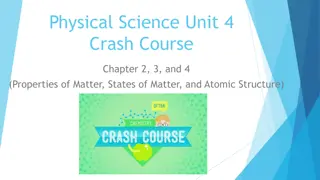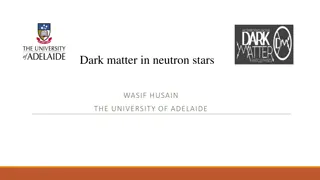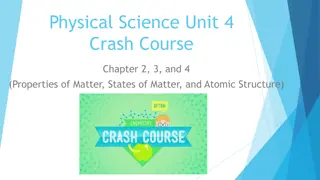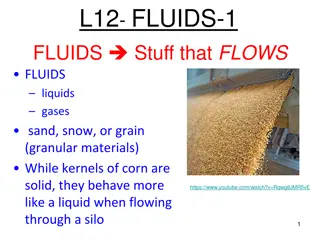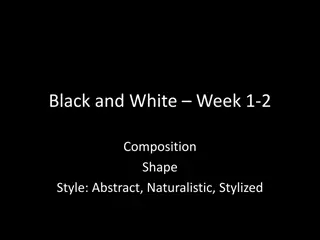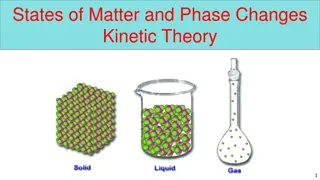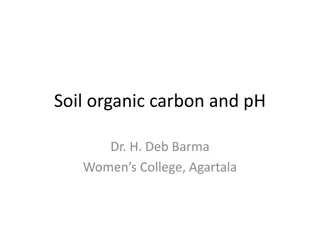Introduction to Chemistry: Matter, Energy, and Measurement
Chemistry is the study of matter, its properties, and the changes it undergoes. This content covers the basics of chemistry, including the classification of matter into pure substances and mixtures, different states of matter, and the building blocks of matter such as atoms and molecules. Sample exe
5 views • 51 slides
Properties and States of Matter in Physical Science
Matter is made up of elements that cannot be broken down further. Different mixtures have distinct properties, such as solutions, colloids, and suspensions. Physical properties like viscosity and density can be observed without changing the material's composition. Chemical properties, like flammabil
2 views • 15 slides
Composition of Soil Organic Matter in Soil Microbiology
Soil organic matter is vital for soil properties and plant nutrition. It consists of plant residues, animal remains, and microbial tissues, comprising complex compounds like carbohydrates, proteins, fats, and more. The composition varies with plant type, age, and nature. Leguminous plants are rich i
0 views • 19 slides
Nutritive Value and Composition of Eggs by Dr. Sushma Kumari
The composition and nutritive value of eggs, as presented by Dr. Sushma Kumari from Bihar Animal Sciences University, cover various aspects including the physical composition of eggs, the composition of an eggshell, and the chemical composition of eggs. The presentation delves into details such as t
0 views • 19 slides
Determining Dry Matter Content of Grass: A Comprehensive Study
The study aims to determine the dry matter content of grass using a detailed method involving sample preparation, oven drying, and calculations. By following the outlined procedure, the dry matter percentage of grass samples can be accurately measured, providing valuable insights into nutrient compo
5 views • 5 slides
Atoms and the Periodic Table
Explore the fundamentals of atoms and matter, including the conservation of matter, mixtures, pure substances, and the properties of metals, metalloids, and nonmetals. Discover the significance of valence electrons, the neutral state of atoms, and the classification of elements on the periodic table
0 views • 13 slides
Matter in Our Surroundings
Matter in Our Surroundings discusses the classification of matter, physical nature of matter, and the properties of matter particles such as size, space between them, and continuous movement. It explains how matter is made up of particles and how they interact with each other through various activit
0 views • 27 slides
Soil Composition and Importance
Explore the world of soil and its significance as a natural resource by discovering its composition and how it affects plant growth. Learn about the main ingredients of soil, its permeability, and the role of water, air, and organic matter. Gain insights into how soil supports plant life through lea
1 views • 30 slides
Unveiling Dark Matter Mysteries Through Dark Photons
Delve into the exploration of dark matter through the lens of dark photons in the galactic center and detectors. Uncover the enigmatic nature of dark matter, its interactions, existing constraints, and our model with fermionic dark matter and a dark photon mediator. Discover strategies to evade cons
0 views • 18 slides
Dark Matter in Neutron Stars
Investigate the interaction of dark matter within neutron stars, comprising approximately 25% of the universe's total matter. The nature of dark matter assumptions, its distribution within neutron stars based on fermionic or bosonic properties, and the implications for self-interacting fermionic and
1 views • 22 slides
Matter and its Classification in Chemistry
Matter is defined as anything that occupies space and has mass. It can be classified into solids, liquids, and gases, as well as pure substances and mixtures based on their composition. This overview covers the states of matter, Aristotle's four elements theory, and the classification of matter into
0 views • 13 slides
Searching for Dark Photon Dark Matter with Cosmic Ray Antideuterons
Exploring the use of cosmic ray antideuterons for dark matter detection is a promising avenue in astrophysics. Antideuteron searches offer a low-background environment, making them ideal for detecting certain types of dark matter particles. Unlike antiproton searches, which face significant backgrou
0 views • 30 slides
States of Matter and Kinetic Theory
Matter is anything that occupies space and has mass, existing in solid, liquid, gas, and plasma states. The states of matter depend on the arrangement and motion of atoms. Solids have fixed shapes, liquids take the shape of their container, and gases fill the volume of their container. The Kinetic T
0 views • 18 slides
Exploring the World of Matter and Elements
Matter is the physical "stuff" of the universe, encompassing elements that make up rocks, wood, air, metals, water, and living organisms. Chemical elements are the building blocks of matter, with essential elements like oxygen, carbon, hydrogen, and nitrogen constituting a significant part of living
0 views • 24 slides
Matter and Physical/Chemical Changes in Science Class
Delve into the world of matter and its transformations through engaging activities such as classifying elements, compounds, and mixtures using nuts, bolts, and washers. Understand the concepts of mass, space, and the different types of matter through hands-on learning experiences in this interactive
0 views • 31 slides
Atomic Structure and Laws of Matter
Explore the fundamental concepts of atomic structure, including the size of atoms, evidence of atomic composition, and key laws of matter such as the Law of Conservation of Mass. Delve into the historical understanding of atomic structure and the contributions of significant scientists like John Dal
0 views • 29 slides
Properties and States of Matter in Physical Science
Matter, comprising elements and compounds, exhibits various physical and chemical properties. Mixtures can be solutions, suspensions, or colloids, each with distinct characteristics. Physical changes maintain substance composition, while chemical changes alter it. States of matter include solid, liq
0 views • 15 slides
Percentage Composition in Chemistry
Percentage composition is crucial in determining the elemental composition of compounds. This lesson explains how to calculate percentage composition using molar masses, illustrated with examples like copper sulfide. It also delves into hydrated salts and their significance in chemistry. Students wi
0 views • 22 slides
Gray Matter in the Brain: Structure, Function, and Importance
Gray matter in the brain plays a crucial role in information processing and cognitive functions. Composed of neuronal cell bodies and unmyelinated axons, gray matter is visibly pinkish-gray and is essential for various brain functions. It forms a synaptically dense area with fewer cell bodies compar
0 views • 7 slides
Dispersed Organic Matter in Sedimentary Rocks - Review Paper for Geological Application Studies in the 21st Century
The WG on Dispersed Organic Matter in Sedimentary Rocks is working on a review paper focusing on application studies of dispersed organic matter (DOM) within a geological context. The paper aims to provide an insightful overview titled "Applications of Dispersed Organic Matter Petrology in the 21st
0 views • 18 slides
Matter: Solids, Liquids, Gases, and Fluids
Matter exists in various states - solid, liquid, gas, and fluid. Solids have atoms closely packed, liquids have more freedom but still cohesion, gases have atoms spread out, and fluids flow like liquids or gases. Mass density characterizes matter based on atom proximity. Gas pressure results from mo
0 views • 22 slides
Future Prospects in Dark Matter Research at Fermilab
Exploring new avenues in the realm of dark matter research, Fermilab stands at the forefront with potential upgrades to their detectors, such as the LZ and PICO-X. The presentation delves into the scientific criteria influencing the choice of detectors, the pursuit of understanding dark matter and d
0 views • 6 slides
Composition in Art: Techniques and Examples
Explore the concept of composition in art through various styles such as abstract, naturalistic, and stylized representations. Learn about the vocabulary and skills necessary for effective composition, with examples from renowned artists like Leonardo da Vinci, Georges Seurat, and more. Discover how
0 views • 43 slides
Properties of Matter in the Matter and Change Unit
Exploring matter, mass, weight, volume, and states of matter in the context of physical properties and compositions of substances. Discover how substances differ, the importance of uniform composition in materials, and the distinction between substances and mixtures.
0 views • 23 slides
Matter: States, Properties, and Changes
Matter is anything with mass and volume, existing in solid, liquid, or gas states. The Kinetic Molecular Theory explains the behavior of particles in matter. Chemistry explores matter through chemical and physical changes. Different factors, like temperature, can change the state of matter. Physical
0 views • 6 slides
Exploring the Properties of Matter: Composition and Changes
Delve into the intriguing world of matter with this lesson on its composition and transformation. Discover how matter is made of atoms and molecules, and explore how it can change from solids to liquids and vice versa. Engage in hands-on activities and collaborative presentations to deepen your unde
0 views • 9 slides
Matter: Properties and Changes
Matter is anything that has mass and volume. This includes the concepts of mass, volume, chemical changes, temperature effects, particle model, kinetic molecular theory, and describing matter based on physical properties. Learn about different states of matter, such as solids, liquids, and gases, an
0 views • 9 slides
Kinetic Theory of Matter and Phases
Explore the fundamental concepts of the Kinetic Theory of Matter, including the three pillars of kinetic energy and forces of attraction, which determine the states of matter like solid, liquid, gas. Learn about temperature, phase changes, and the phases of matter, emphasizing the role of kinetic en
0 views • 17 slides
Food Chains: Does Matter Disappear Along the Way?
In this lesson on food chains, students investigate whether matter disappears as it moves from one organism to another. Using a linking-cube simulation, they track food molecules mathematically to determine if any matter is lost in the process. The lesson involves hands-on activities and observation
0 views • 30 slides
Nature of Matter: Unit Project Overview
Embark on a journey to understand the structures and bonds of matter through a comprehensive unit project. Delve into atoms, molecules, compounds, pure substances, mixtures, phases of matter, properties, periodic table, and conservation laws. Explore matter classification and phase changes' relation
0 views • 9 slides
Introduction to Chemistry and Matter
Understanding chemistry involves studying the properties of matter and its changes. Matter is anything that occupies space and has mass, composed of vibrating atoms. It includes examples like air, water, books, desks, and people, while non-examples are light, sound, thoughts, and emotions. Physical
1 views • 18 slides
Matter and Energy in Chemistry: A Comprehensive Overview
Exploring the intricate nature of matter, this collection delves into the fundamentals of chemistry, from the macroscopic to the particulate level. Covering topics such as the states of matter, kinetic nature, physical properties, and other states of matter like plasma and Bose-Einstein condensate,
0 views • 18 slides
Matter and its Properties
Matter is the fundamental component of everything around us, existing in various forms such as solids, liquids, and gases. This article delves into the states of matter, chemical changes, physical changes, and the kinetic molecular theory, shedding light on the basic building blocks of life and the
0 views • 8 slides
Matter and Its Changes
Matter is anything that has mass and takes up space. By identifying physical properties and understanding physical changes, we can explore the different states of matter - solid, liquid, gas, and plasma. Measuring properties like length, mass, volume, and density helps us characterize and differenti
0 views • 24 slides
Dark Atom Effects on Structure Formation in the Universe
Overwhelming evidence points towards the existence of dark matter in the universe, with various theoretical models such as OHe atoms and Glashow's EIMP model proposed to explain its nature. Dark OHe atoms, consisting of 2 charged particles bound with primordial He nuclei, offer a unique perspective
1 views • 8 slides
Dark Matter Search at Terascale Meeting in Strasbourg
Doojin Kim presents research on non-relativistic dark matter search, focusing on weakly interacting massive particles (WIMPs) and generic boosted dark matter (BDM) signatures at the Terascale Meeting in Strasbourg. The study explores various scenarios and production models for detecting elusive dark
0 views • 24 slides
The Particle Theory of Matter
Matter, as described by the Particle Theory, is composed of tiny particles in constant motion with spaces between them. This theory, formulated by John Dalton, explains the behavior of matter based on four principles. It elaborates on the structure, motion, and interactions of particles within subst
0 views • 19 slides
Revealing the Dark Matter Profile of the Milky Way
Xiaowei Ou and collaborators aim to infer the dark matter profile of the Milky Way by measuring its circular velocity curve. By utilizing stellar tracers and data-driven models for precise distances, they seek to improve our understanding of dark matter distribution in our galaxy. Their research inv
0 views • 54 slides
K* in Dense and Hot Matter
Investigate the properties of kaons in various types of matter, such as dense nuclear matter and hot hadronic matter. Explore decay modes, probes for dense matter, and changes in kaon properties in dense matter. Analyze in-medium energy and kaon potentials. Study the influence of in-medium K+ potent
0 views • 21 slides
Soil organic carbon and pH
Soil organic carbon, a measurable component of soil organic matter, plays a crucial role in soil acidity control, nutrient cycling, and pollutant degradation. Learn about the differences between soil organic carbon and soil organic matter, the composition of soil organic matter, and the distinct fra
0 views • 15 slides

